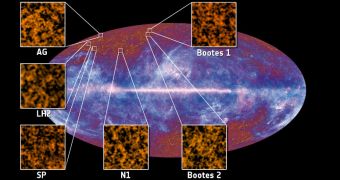At a press conference held in Paris, France today, January 11, officials at the European Space Agency (ESA) presented the first scientific results of the Plank mission, which observes the Universe and its microwave background at very high resolution.
Most of the announcements that were made today had to do with some of the coldest objects that can be found out there, starting from our own Milky Way and ending in the farthest reaches of outer space.
The new discoveries Planck allow s to take on a new perspective on how the Universe (the stage) interacts with galaxies (the actors) and vice-versa. The dance that these two are engaged in is what shapes the evolution of the Cosmos, ESA representatives say.
Cameras aboard the ESA telescopes generated the first full-sky images in July 2010, and the products were released shortly afterwards, But this is the first time that genuine scientific data come out of the state-of-the-art mission.
Most of the findings are detailed in no less than 25 papers, all of which have been submitted for publication in an upcoming issue, or issues, of the esteemed scientific journal Astronomy & Astrophysics. The results were presented by the Planck Collaboration.
The new “Early Release Compact Source Catalog” was produced by piecing together observations that the amazing telescope conducted of the entire sky, at millimeter and submillimeter wavelengths. Several thousand of new, cold objects are listed in the Catalog.
Now that the international astronomical community knows where the new objects are, it can train its telescopes and observatories on them, and get to know these objects better. Some of them may even yield more clues to how galaxies or planets form, or how our solar system came to be.
“This is a great moment for Planck. Until now, everything has been about collecting data and showing off their potential. Now, at last, we can begin the discoveries,” explains ESA Planck project scientist Jan Tauber.
“This is a first step, we are just learning how to work with these data and extract the most information,” explains scientist Jean-Loup Puget, who is based at the CNRS-Université Paris Sud, in Orsay, France.
One of the most interesting things that Planck has seen is an invisible population of galaxies, which its sensitive detectors picked up hiding in a large shroud of dust, several billion light-years away.
The galaxies in that group produced young, blue stars at rates that exceeded the Milky Way's star-producing capability by 10 to 1,000 times over. No other observatory has ever seen these galaxies at millimeter and submillimeter wavelengths before.
“This is a great result made possible by the exceptional quality of the Planck data,” explains University of Manchester astronomer Clive Dickinson.
In addition, the Planck Collaboration announces that the telescope has seen 189 distant galaxy clusters, of which 20 were unknown previously. The XMM-Newton X-ray observatory is currently working hard to confirm the discoveries.
“Today’s results are the tip of the scientific iceberg. Planck is exceeding expectations thanks to the dedication of everyone involved in the project,” explains the ESA Director of Science and Robotic Exploration, David Southwood.
“However, beyond those announced today, this catalog contains the raw material for many more discoveries. Even then, we haven’t got to the real treasure yet, the cosmic microwave background itself,” the official goes on to say.
According to ESA representatives, the Planck Collaboration will release its next batch of data no early than January 2013. All-sky maps that the telescope will create until then will be released, but another series of studies such as the ones is two years away.

 14 DAY TRIAL //
14 DAY TRIAL //